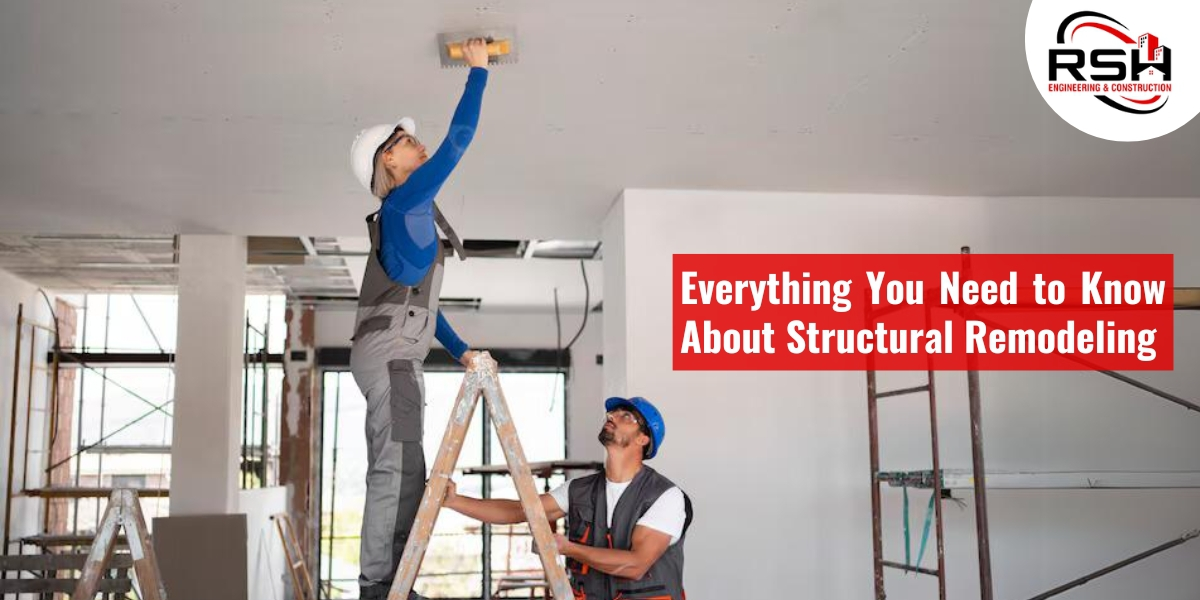Structural remodeling can give your home a new look or improve its functionality. Whether you aim to increase the size of your living space, represent your design, or fix your structural issues, this guide will give you a deep understanding of what you should involve to find the right contractors.
Moving thoroughly ahead we’ll let you know how you can transform your home by remodeling it with the help of local home inspectors to ensure your renovation process goes smoothly.
What is Structural Remodeling?
Structural remodeling refers to modifications that affect your home’s basic framework or structure. This could involve tearing and shearing walls, building floor extensions, or even shifting the structure of your house. Like other painting or installing new cabinets, structural renovation deals with the bones of the house, such as:
- Load-bearing walls
- Foundation work
- Beans and support structures
- Roofs and ceilings
The above changes require approvals, a deep examination, and license of an experienced structural remodeling contractor.
Benefits of Structural Remodeling
- Increased Home Value: A well-done structural renovation can significantly increase the value of your property.
- Improved Functionality: Structural remodeling can help you optimize the space in your home for better functionality.
- Updated Aesthetics: Whether modernizing the design or adapting the space to current needs, remodeling gives a fresh and updated look.
Key Elements to Consider in Structural Remodeling
Before diving into a structural remodeling project, several factors need to be considered:
1. Understanding the Scope of Work
You need to have a clear understanding of the structural modifications required. It is necessary to identify the areas that need change—whether it is expanding a room or removing a wall—so that the renovation will meet your needs. Work closely with a house renovation contractor who can help you define the project’s scope accurately.
2. Hiring Structural Remodeling Contractors
Working with experienced structural remodeling contractors is crucial for a successful renovation. Not all contractors specialize in structural work, so hiring those with experience in significant remodeling tasks like foundation repairs or structural reinforcements is essential.
Be sure to:
- Check their qualifications and certifications.
- Ask for references and previous projects.
- Ensure they have insurance to cover any accidents or damages during remodeling.
3. Structural Inspection
A thorough structural inspection is often the first in any remodeling project. This involves having a licensed professional assess your home’s current structural integrity. An inspector will evaluate critical areas like the foundation, load-bearing walls, and roofing structures to ensure they can handle the upcoming changes.
Why a Structural Inspection is Important:
- Identifies hidden issues like cracks or shifts in the foundation.
- Ensures that your home is safe to undergo structural changes.
- It helps to avoid unexpected costs during the remodeling process.
4. Local Home Inspectors
Hiring local home inspectors is necessary during the structural remodeling process. They will ensure that your renovation meets all local building codes and regulations. Their role is to:
- Provide a comprehensive home inspection report.
- Offer guidance on necessary permits and code compliance.
- Conduct follow-up inspections throughout the remodeling process.
Planning a Structural Renovation: Step-by-Step
A successful structural remodeling project requires careful planning.
A step-by-step guide to help you organize your renovation:
Step 1: Assess Your Needs
Start by evaluating what areas of your home need improvement and why. Do you want to make space for a growing family? Are you looking to open up the floor plan? Knowing your goals will guide your decisions throughout the renovation process.
Step 2: Create a Budget
Structural remodeling can be expensive, so it is essential to set a realistic budget. Add costs for materials, labor, inspections, and permits. Make sure to allocate a portion of the budget for unexpected expenses.
Step 3: Get Permits
Most structural remodeling projects require permits from your local government. These permits ensure that the renovation meets safety standards. Working with a structural remodeling contractor who understands local regulations will make this step easier.
Step 4: Hire the Right Contractor
Take the time to find the right structural remodeling contractor. Look for someone with a proven track record in handling large projects and an understanding of design and structural integrity.
Step 5: Design and Layout
Work closely with your contractor and possibly a structural engineer to design the new layout of your home. Structural renovations often involve load-bearing elements, so it is necessary that the design doesn’t compromise the stability of your home.
Step 6: Monitor the Construction
During the remodeling process, make sure to keep open communication with your contractor. Regular inspections from local home inspectors can help ensure the work is done according to code and your specifications.
Common Types of Structural Remodeling Projects
There are several types of structural remodeling projects homeowners typically undertake, each serving different purposes:
- Room Addition: Expanding the size of your home by adding new rooms or extensions.
- Removing Load-Bearing Walls: This opens up the house’s layout, creating layer living spaces.
- Foundation Repairs: Addressing issues related to uneven or cracked foundations.
- Roofing Adjustments: Raising the height of ceilings or fixing structural problems with the roof.
Structural Design and Its Importance
When undertaking a structural renovation, design plays a pivotal role. Your remodel’s design should reflect the space’s aesthetic and functional aspects. Structural design encompasses the visual appeal of the renovation changes and the sound and safety.
- Aesthetic Appeal: Modernizing your home’s layout can drastically improve its appearance.
- Practically: A well-thought-out design ensures that your new space will be functional and comfortable.
- Safety: Design decisions must account for the home’s load-bearing capacities and overall integrity.
The Role of Home Inspection Checklist:
Having a home inspection checklist can be very helpful when planning a structural remodeling project. It ensures that all important aspects of the home’s structure are reviewed before, during, and aftering the renovation.
Essential Items to Include in Your Checklist:
- Foundation stability
- Condition of load-bearing walls
- Roofing structure
- Plumbing and electrical systems
- Any signs of water damage or pest infections
A detailed checklist will help you avoid overlooking crucial elements during your remodeling project.
Final Thoughts
Structural remodeling can transform your home into the space of your dreams, but it’s essential to approach it with careful planning and the right team of professionals. By understanding the critical elements given by RSH Engineering Constructions and Services, you’ll find that by hiring experienced structural remodeling contractors and conducting thorough structural inspections, you can ensure that your renovation will be both safe and successful.
With the right approach, structural remodeling can offer a fresh look and a safer and more functional home for you and your family.





